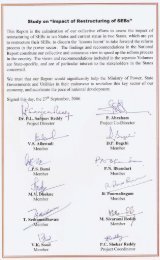MoP - Ministry of Power
MoP - Ministry of Power
MoP - Ministry of Power
You also want an ePaper? Increase the reach of your titles
YUMPU automatically turns print PDFs into web optimized ePapers that Google loves.
1. CONSTITUTION OF CEA<br />
CENTRAL ELECTRICITY AUTHORITY<br />
The Central Electricity Authority (CEA) is a statutory<br />
organisation originally constituted under Section 3(1) <strong>of</strong> the<br />
repealed Electricity (Supply) Act, 1948 since substituted by<br />
Section 70 <strong>of</strong> the Electricity Act, 2003. It was established<br />
as a part- time body in the year 1951 and made a full- time<br />
body in the year 1975.<br />
As per section 70(3) <strong>of</strong> the Electricity Act, 2003, Authority<br />
shall consist <strong>of</strong> not more than 14 members (including its<br />
Chairperson) <strong>of</strong> whom not more than 8 are full-time<br />
members who are appointed by the Central Government<br />
from amongst the eminent engineers/executives having<br />
knowledge and experience in various areas <strong>of</strong> <strong>Power</strong> Sector.<br />
CEA is headed by a Chairperson who oversees largely the<br />
development <strong>of</strong> <strong>Power</strong> Sector in the country. A Secretary,<br />
appointed by the Authority with the approval <strong>of</strong> the Central<br />
Government under section 72 <strong>of</strong> Electricity Act 2003, assists<br />
him in the discharge <strong>of</strong> CEA’s statutory functions. The<br />
Secretary also assists the Chairperson in all matters<br />
pertaining to administration and technical matters including<br />
Human Resource Development and techno-economic<br />
appraisal & concurrence <strong>of</strong> power projects etc. Presently,<br />
there are six wings namely Planning, Hydro, Thermal, Grid<br />
Operation & Distribution, Economic & Commercial and<br />
<strong>Power</strong> System each headed by a Member <strong>of</strong> the Authority.<br />
Under each Member, there are technical Divisions each<br />
headed by an <strong>of</strong>ficer <strong>of</strong> the rank <strong>of</strong> Chief Engineer.<br />
2. FUNCTIONS OF CEA<br />
The functions and duties <strong>of</strong> the Authority are delineated<br />
under Section 73 <strong>of</strong> the Electricity Act, 2003. Besides, CEA<br />
has to discharge various other functions as well under<br />
Section 3, 7, 8, 53, 55 and 177 <strong>of</strong> the Act. During the year<br />
2007-08 (upto 30-11-2007), two regulations viz. Regulations<br />
on Technical Standards for Connectivity to the Grid and<br />
Regulations on Furnishing <strong>of</strong> Statistics, Returns and<br />
Information have been notified. Regulations on Grid<br />
Standards for Operation & Maintenance <strong>of</strong> Transmission<br />
Lines have been sent to <strong>MoP</strong> for Gazette Notification. The<br />
Regulations on Technical Standards for Constructions <strong>of</strong><br />
Electrical Plants and Electric Lines and the Regulations on<br />
Measures relating to Safety and Electric Supply have been<br />
pre-published and are being finalized considering the<br />
comments/suggestions <strong>of</strong> various stakeholders in the <strong>Power</strong><br />
Sector.<br />
TECHNO-ECONOMIC APPRAISAL OF POWER DEVELOPMENT SCHEMES<br />
The Central Electricity Authority, had been according<br />
Techno-Economic Clearance/ Appraisal to generation<br />
schemes (Hydro & Thermal) and Transmission schemes<br />
etc. under the then Electricity (S) Act, 1948 before<br />
enactment <strong>of</strong> The Electricity Act, 2003. CEA's consultation<br />
u/s 44 (2A) <strong>of</strong> repealed Electricity (Supply) Act, 1948<br />
was also being conveyed to the concerned State Electricity<br />
Boards / Regulatory Commissions for captive power<br />
plants. The Electricity Act, 2003 came into force w.e.f.<br />
CHAPTER - 19<br />
10th June, 2003. As per The Electricity Act, 2003,<br />
concurrence <strong>of</strong> CEA is now required only for hydro<br />
Generating Schemes. Techno-Economic Clearance <strong>of</strong> CEA<br />
to Thermal generation and Transmission Schemes as well<br />
as captive power plants are not required now.<br />
During the year 2006-07, upto 31.3.2007, Central Electricity<br />
Authority accorded Concurrence to 10 Nos. Hydro<br />
Generating Scheme aggregating to a capacity <strong>of</strong> 4855 MW.<br />
The details <strong>of</strong> these schemes are given below:-<br />
DETAILS OF HYDRO SCHEMES APPRAISED BY CENTRAL ELECTRICITY AUTHORITY FROM APRIL’ 2006 TO<br />
MARCH’ 2007:<br />
Sl. Name <strong>of</strong> Scheme Installed Estimated Cost Date <strong>of</strong> CEA<br />
No. State<br />
Executing Agency<br />
Capacity (MW) Clearance<br />
1. Teesta Stage-III HEP 6x200=1200 Rs. 5705.55 crs. 12.05.06<br />
Sikkim (Estimated completion<br />
M/s Teesta Urja Ltd. cost)<br />
2. Rammam Stage-III HEP 3x40=120 Rs. 633.92 crs. 12.09.06<br />
West Bengal (Present day cost)<br />
NTPC Hydro Ltd. (2/06 Price Level)<br />
3. Vishnugad Pipalkoti, HEP 4x111=444 US$ 13.5 Million + 21.9.06<br />
Uttaranchal Rs.2031.64 crs.<br />
M/s THDC Ltd. (Present day cost)<br />
(3/06 Price Level)<br />
(ER : 1US$=Rs. 44.30)<br />
69

















